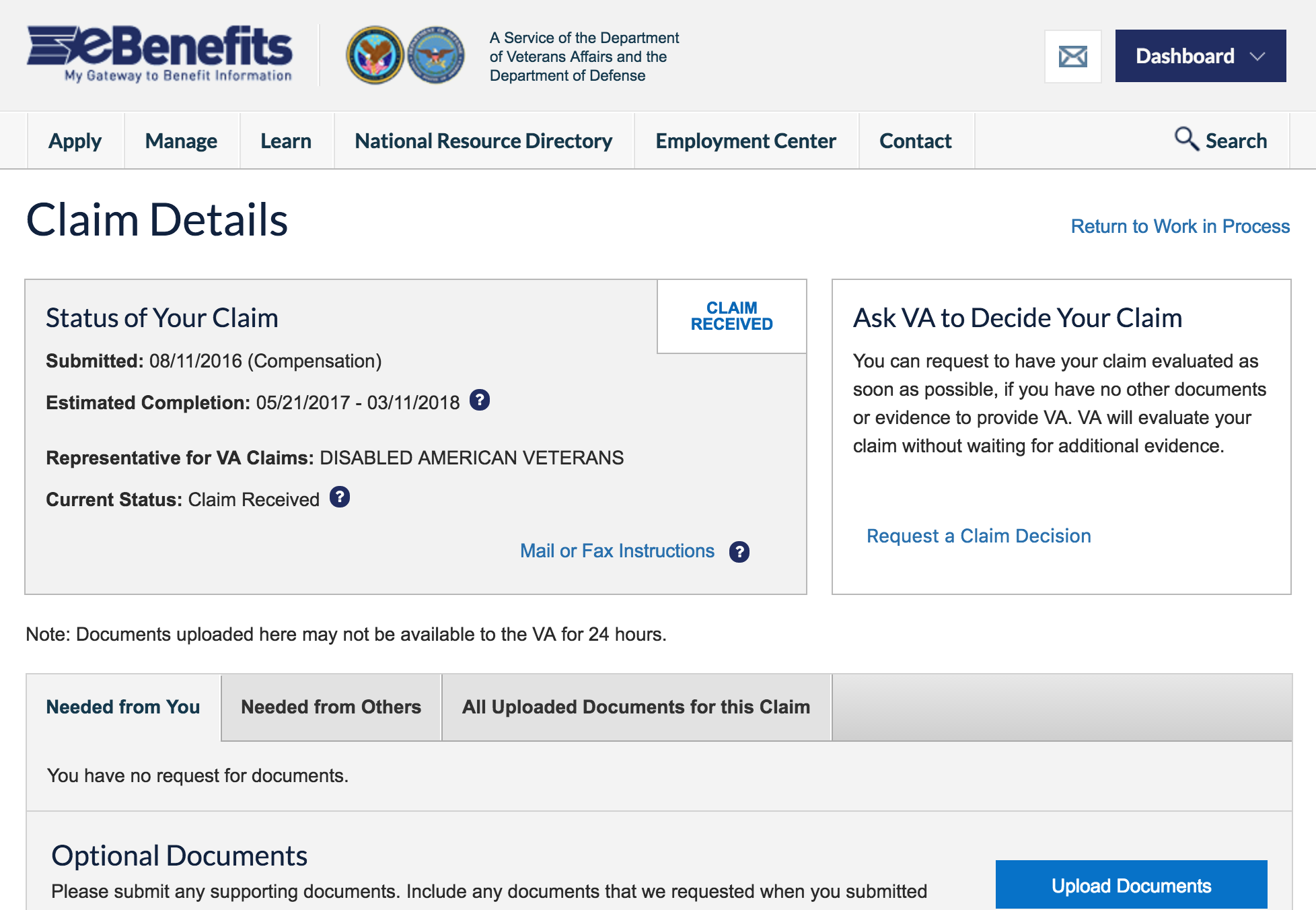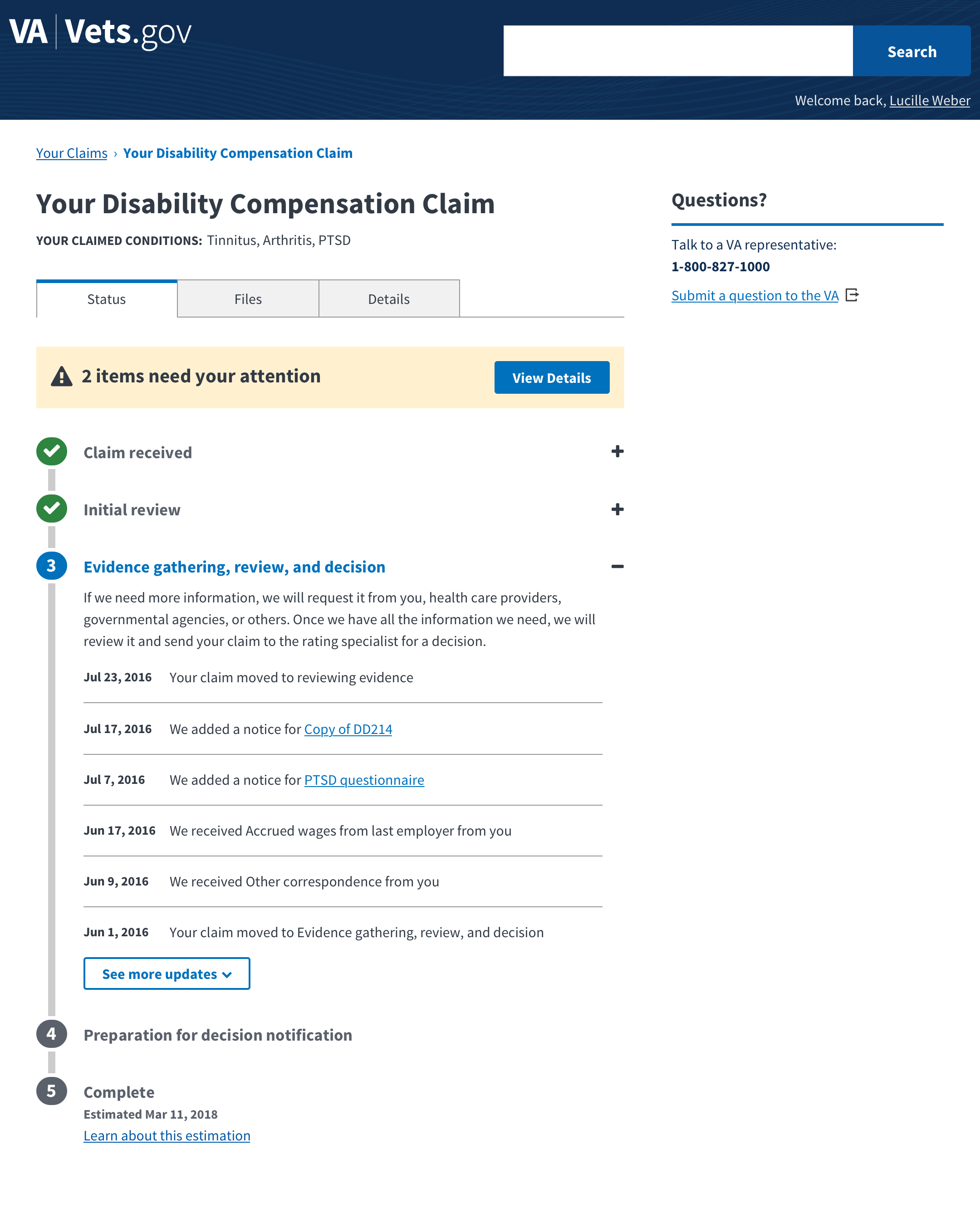Vets.gov Claim Status
Simplifying the disability claims tracking process for Veterans.
My role
Discovery & stakeholder interviews
Ideation, UI design, & prototyping
UX writing & content strategy
About Vets.gov
Vets.gov was a beta site developed by the VA to bring all Veteran-facing tools and brands under one roof. In 2018 Vets.gov merged with VA.gov to become the new home for Veterans at the VA.
Veterans' disability benefits
The VA offers disability compensation benefits to Veterans who got sick or injured while serving in the military. To receive those benefits, Veterans must apply and submit medical evidence of their disability in order for the VA to determine how much compensation they're eligible for.
Once a Veteran applies for disability compensation, it can take anywhere from 3-10 months for them to receive a decision. While they were able track the status of their claim online, the information available was often vague and didn't tell them much about when they could expect to get a decision. When the online status is unclear, Veterans try other means by calling the VA.
At the time this work started (Fall 2016), 42% of all calls to the VA National Call Center were related to claim status.
Discovery
The discovery process included reviewing prior in-house research and interviewing stakeholders and subject matter experts such as Veteran Service Officers (VSOs), who help Veterans submit disability claims. We also evaluated the current online interface for tracking claim status through a heuristic analysis and usability testing to understand Veterans' pain points with the experience.
Pain points

eBenefits, the VA's existing claim status tool
The recurring theme found through the discovery process was lack of transparency — many confusing things could happen, and often without explanation:
- The estimated completion date changes or disappears altogether
- The status of the claim moves backwards a step
- The status isn't descriptive or doesn't change for long periods of time
- When a decision is finally received, the path forward in an unfavorable outcome is unclear
“I found my status but, somehow I keep having to send the same information over and over again. I've been getting the run around for over 2 years. When does it end?”
Goals
Through the concerns we heard from Veterans, my team set out with three core goals in mind:
- Use layman's terms, not the VA's, to clearly explain the status of a claim
- Expose more detail about what the VA is doing at any given step in the process to reinforce the sense of progress, even when incremental
- Establish a clear hierarchy that prioritizes actions the Veteran needs to take, or can take to expedite the process
Ideation
Early explorations focused on hierarchy experiments, different ways to visualize the timeline and progress, and the balance of information on the page.

Experiment 1:Focusing on current phase and displaying progress based on journey to completion date to reinforce a sense of forward movement.

Experiment 2:Combining the two steps where backward movement is most likely to occur.

Experiment 3:Using visual cues in the timeline graphic to generally indicate expected time length for each phase.
Refined concept
I distilled the best elements from each of the early explorations –— clear hierarchy, transparency and detail, and straightforward language - to develop one unified concept that best meets these core goals.
Minimized backward movement
Through input from claims processors, we learned about the steps in the process where there was a high likelihood of moving backwards in the process. We combined these into a single step to minimize appearance of backward movement. This also reduced the overall number of steps in the process with the goal of simplifying the experience.
Prioritized calls to action
Focusing the hierarchy of the interface to prioritize any actions the Veteran needs to take, like uploading a medical record as evidence for their claim.
Micro-transactions
Surfacing smaller, detailed status updates more visibly to emphasize the sense of progress and recency. In the current tool these were minimized and most focus was given to the step in the process and estimated completion date.
Timestamps
Displaying the last time data was received from the backend data source, to provide reassurance that the information shown is up to date, even if nothing appears to have changed.
Date stability
Rather than showing a range for the estimated completion date, show only the later date in that range, and provide detail to Veterans around why that date may change.
User feedback
We put our concepts in front of Veterans who had been through the disability claims process before. They expressed a lot of positive feedback and felt the new experience simultaneously gave a lot more useful information, while cutting down on the extraneous and unhelpful details.
“This is where it's at. It's streamlined, there's no nonsense in there.”
“I feel like I have a lot more information on the status. The timeline, listing out the steps - it shows what's happening at each point in time.”
“Even though there are a lot of people that use computers now, making them simple like they do for us seniors...it needs to be spelled out and simple to work. It doesn't need to be a complicated process.”
Launch
Claim status successfully launched on Vets.gov in December 2016. Work continued after the initial launch to support all types of VA claims (such as pension claims and Veteran burial allowances) and integrate tracking the status of appeals (when a Veteran is denied their application for benefits, they can go through a process to appeal it).
Since Vets.gov merged with VA.gov in November 2018, this claim status tool is now the primary method for all Veterans to view their claims.

